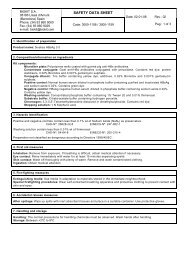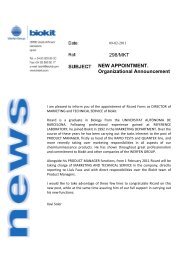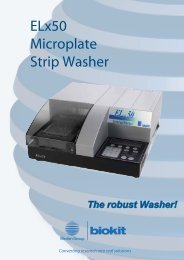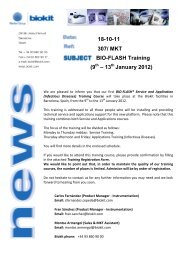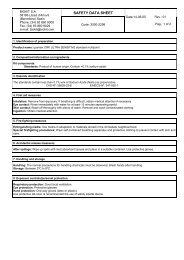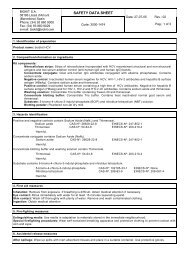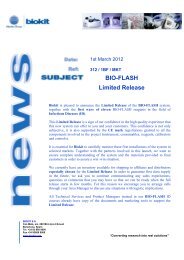Bioelisa HTLV I+II 5.0 Product improvement - Biokit
Bioelisa HTLV I+II 5.0 Product improvement - Biokit
Bioelisa HTLV I+II 5.0 Product improvement - Biokit
Create successful ePaper yourself
Turn your PDF publications into a flip-book with our unique Google optimized e-Paper software.
ioelisa <strong>HTLV</strong>-<strong>I+II</strong> <strong>5.0</strong><strong>Product</strong> <strong>improvement</strong>s:Recombinant antigensbioelisa <strong>HTLV</strong>-<strong>I+II</strong> <strong>5.0</strong> uses a combination of three epitopes collected in a single trifusionrecombinant antigen. The assay assures the detection of both <strong>HTLV</strong>-I and<strong>HTLV</strong>-II by two type specific epitopes derived from the ENV antigens: gp46 I from<strong>HTLV</strong>-I and gp46 II from <strong>HTLV</strong>-II. A third common ENV antigen, gp21, enhances thesensitivity and specificity for both <strong>HTLV</strong>-I and <strong>HTLV</strong>-II.gp21 is the best antigen for detecting <strong>HTLV</strong> as its correspondent antibody is thefirst to appear in the seroconversion of a patient. The gp21 recombinant is also avery specific antigen that does not cross-react with any other viral antigen.Third generation assaybioelisa <strong>HTLV</strong>-<strong>I+II</strong> <strong>5.0</strong> now uses a peroxidase labelled antigen as a conjugateinstead of the former anti-human IgG. It is a real sandwich assay in which all kindsof anti-<strong>HTLV</strong> class antibodies bind simultaneously to the plate coating andconjugate. Specificity and microplate background increases dramatically in thiskind of assay format.Protocol: Single incubation for sample and conjugatebioelisa <strong>HTLV</strong>-<strong>I+II</strong> <strong>5.0</strong> now uses a single incubation for sample and conjugate.Working conjugate is first dispensed into the microwells. The samples are thendispensed directly into the corresponding microwells. A change in the greentonality helps monitor sample addition. This change can also be readspectrophotometrically at 450 nm but definition of the OD limit must be validatedcustomer by customer.Sample and conjugate mixture is incubated for only one hour at 37 °C.After 6 wash cycles, ready-to-use TMB substrate is added and incubated for 30minutes at 37 °C.Test name bioelisa <strong>HTLV</strong>-<strong>I+II</strong> 4.0 bioelisa <strong>HTLV</strong>-<strong>I+II</strong> <strong>5.0</strong>Code number 3000-1156 3000-1165Method EIA/HRP/TMB EIA/HRP/TMBFormat 2 - step indirect method 1 - step direct sandwichSolid phase 12x8 Microtiter wells 12x8 Microtiter wellsTests per kit 192 192Coating Antigens Recombinant antigens Single tri-fusion Recombinant Antigen<strong>HTLV</strong>-I, <strong>HTLV</strong>-II gp46 I and gp46 II gp46 I and gp46 IICommon <strong>HTLV</strong> gp21 gp21ConjugateGoat anti-human IgG labelledwith HRP<strong>HTLV</strong> tri-fusion antigen labelled withHRPSubstrate TMB TMBSpecimen dilution 1/10 In plate dilution20 µl sample200 µl diluent1/2 In plate dilution50 µl Working conjugate50 µl Direct sampleSample incubation 60 min / 37°C 60 min / 37°CConjugate incubation 30 min / 37°C No ApplicableSubstrate incubation 15 min / 37°C 15 min / 37°CCut-off Mean Neg. + 0.450 Mean Neg. + 0.250Sensitivity 99.7% 100%Specificity 99.80% Blood donors 99.82% Blood donorsPage 2 of 9



